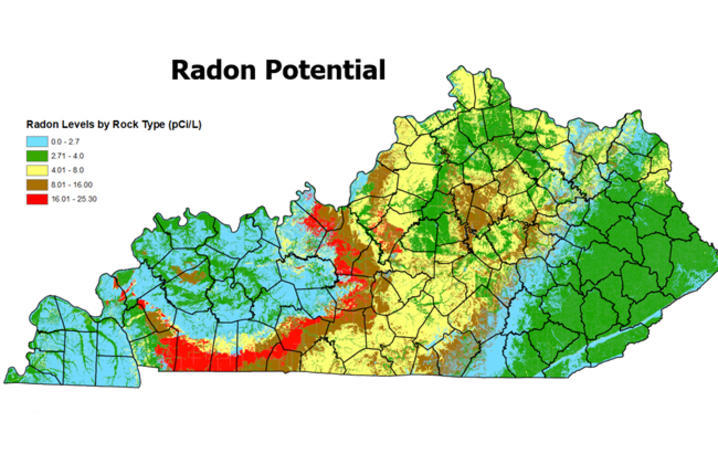UK researchers expand access to radon mitigation in Kentucky with $2.6 million grant

LEXINGTON, Ky. (Nov. 13, 2024) — When people breathe in radon gas, they are more likely to develop lung cancer, particularly when they also breathe tobacco smoke. Radon, a radioactive gas, occurs naturally when uranium breaks down in rock and soil.
Radon is invisible — you cannot smell, see or taste the gas, and there are no immediate symptoms. Most exposure to radon occurs in the home after it seeps in through gaps and cracks around service pipes and in foundations. Because of Kentucky’s geologic makeup, many Kentuckians are unknowingly being exposed to the harmful gas in their home.
Unfortunately, few Kentuckians test for radon, especially in rural areas. In addition, rural Kentuckians often lack access to certified radon professionals who can fix homes with high levels of radon.
“Radon exposure contributes to about 1,000 new cases of lung cancer in Kentucky every year, but only 13 of every 10,000 Kentucky homes have tested for radon,” said Stacy Stanifer, Ph.D., an assistant professor in the University of Kentucky College of Nursing and the principal investigator of RADAR 2.0.
Radon-induced lung cancer is largely preventable by reducing exposure to the gas through radon testing and mitigation. Stanifer applies her knowledge of radon to her additional roles as a member of the Markey Cancer Center’s Cancer Prevention and Control Research Program and College of Nursing’s BREATHE (Bridging Research Efforts and Advocacy Toward Healthy Environments) program.
Researchers in the BREATHE program, the College of Public Health, the College of Arts and Sciences, the Kentucky Geological Survey and other key community partners including public libraries and Area Health Education Centers, are working together to learn how best to protect the public from radon exposure.
The collaboration is part of the five-year RADAR 2.0 project, funded by a $2.6 million grant from the National Institute of Environmental Health Sciences (NIEHS). The project will build on findings from a previous NIEHS-funded study called Radon on the RADAR (Residents Acting to Detect and Alleviate Radon).
RADAR 2.0 will increase access to certified radon professionals through a novel partnership with the Kentucky Community & Technical College System to offer radon measurement and mitigation courses, as well as create and study radon risk messaging that prompts home radon testing and mitigation.
Researchers will also partner with scientists at the Silent Spring Institute to develop and study an online radon report-back website to help the public understand their home’s radon number and make an informed decision about next steps to protect themselves.
The previous study found a lack of access to certified radon mitigation professionals in rural Kentucky and little information on how to best communicate to the public the seriousness of radon exposure, and the importance of testing and fixing high radon. The geologists on the team found a need to further investigate how various types of rock and soil are linked to home radon levels.
Through Radon on the RADAR, researchers have established relationships with community partners and citizen scientists in four Kentucky counties: Christian, Logan, Pulaski and Rowan. The team’s work has enabled these public libraries to loan out radon detectors for free to dramatically increase radon testing over the past five years. The success of these lending programs has garnered interest from libraries across the country and increased the need for professionals skilled in radon mitigation, particularly in rural Kentucky.
“The radon measurement and mitigation courses offered through the Hopkinsville Community College will be the first of its kind,” said Robert Smith, Hopkinsville Community College Construction Technology program coordinator and site principal investigator for RADAR 2.0. “These courses will build a workforce across Kentucky that is ready to build homes using radon-resistant construction techniques and also fix existing homes with high levels of the hazardous gas.”
Additionally, geologists will perform in-depth analysis of the geological processes that relate to heightened indoor radon levels.
“Given the previous finding that carbonate bedrock with relatively low uranium concentrations was associated with homes having high indoor radon levels, we will study the geologic factors of the uranium-bearing minerals in soils and bedrock to deepen our understanding of the soil processes and characteristics that may be related to elevated indoor radon levels,” said Kevin Yeager, Ph.D., a professor in the Department of Earth and Environmental Sciences in the College of Arts and Sciences.
“What we’re doing in this project is crucial for preventing lung cancer in Kentucky,” said Stanifer. “What we learn can help limit the negative impacts of radon nationwide and create a model for other states and municipalities.”
More information on radon, county and statewide data and recommendations for homeowners, can be found on the BREATHE website.
Research reported in this publication was supported by the National Institute of Environmental Health Sciences of the National Institutes of Health under Award Number R01ES030380. The content is solely the responsibility of the authors and does not necessarily represent the official views of the National Institutes of Health.
As the state’s flagship, land-grant institution, the University of Kentucky exists to advance the Commonwealth. We do that by preparing the next generation of leaders — placing students at the heart of everything we do — and transforming the lives of Kentuckians through education, research and creative work, service and health care. We pride ourselves on being a catalyst for breakthroughs and a force for healing, a place where ingenuity unfolds. It's all made possible by our people — visionaries, disruptors and pioneers — who make up 200 academic programs, a $476.5 million research and development enterprise and a world-class medical center, all on one campus.




